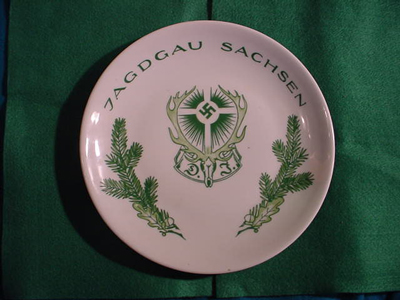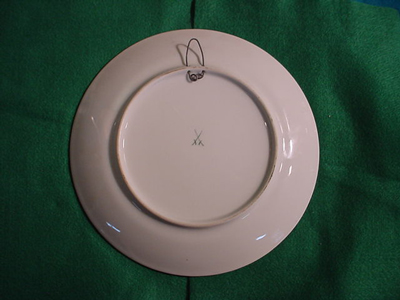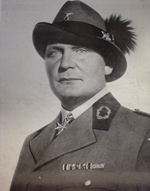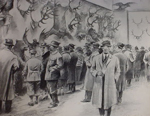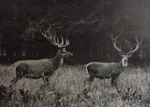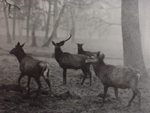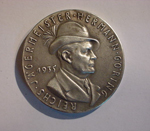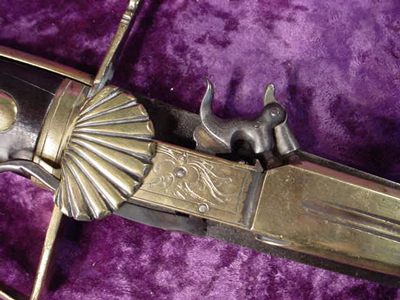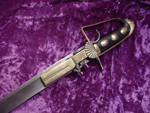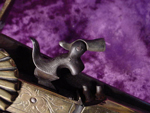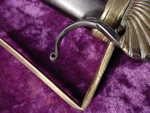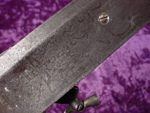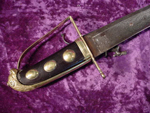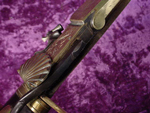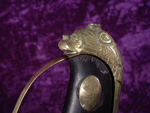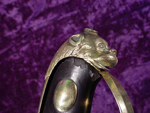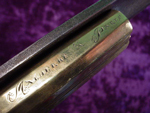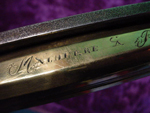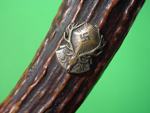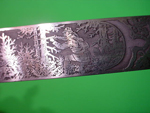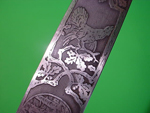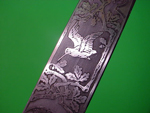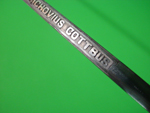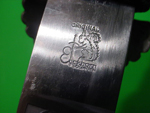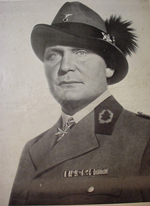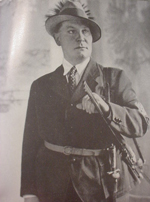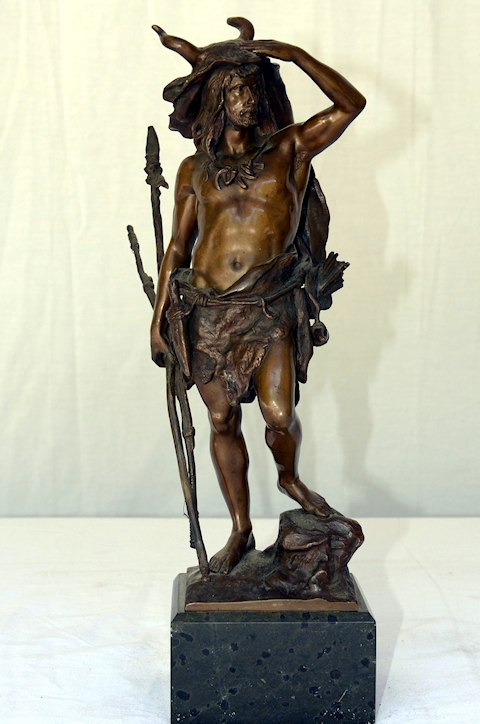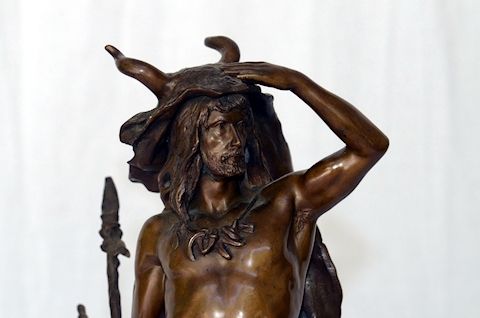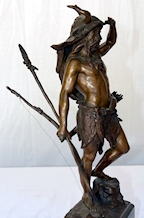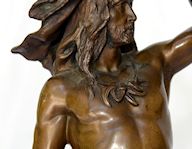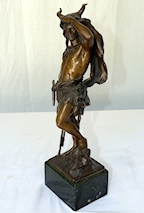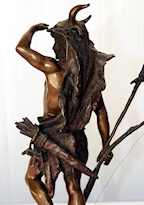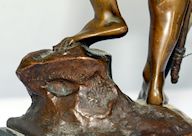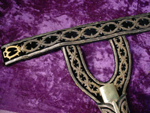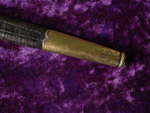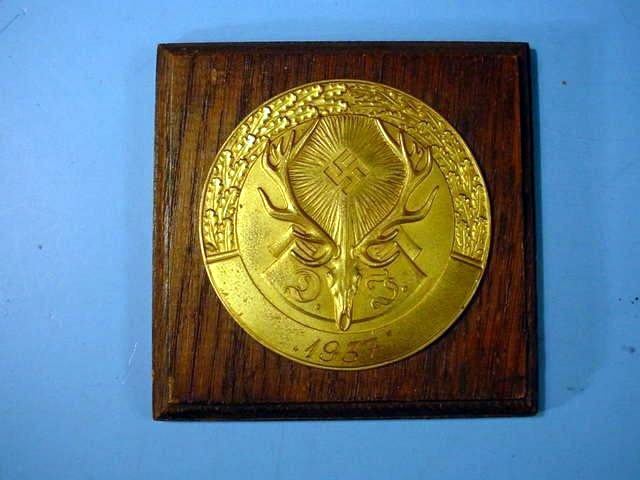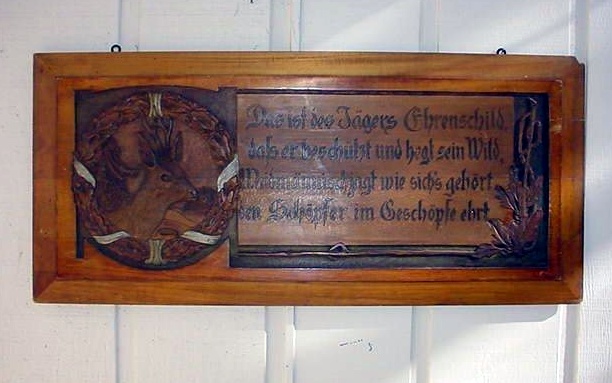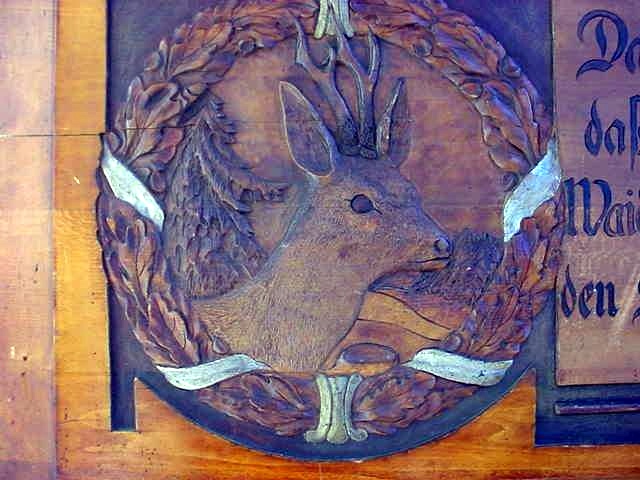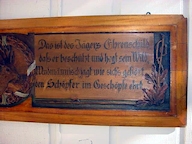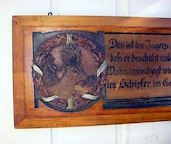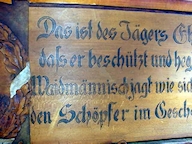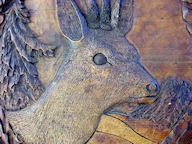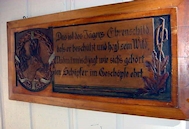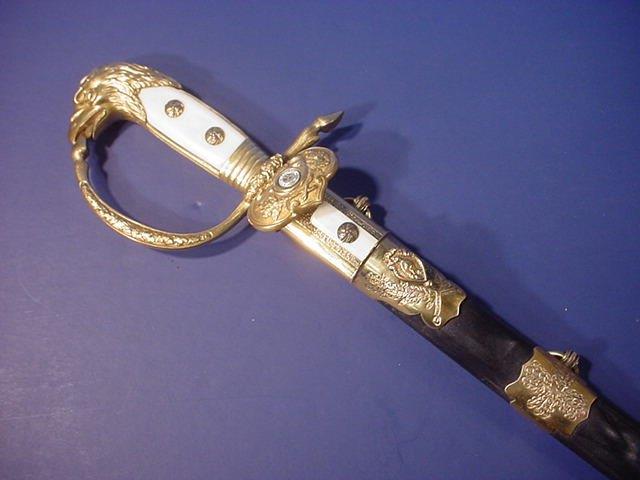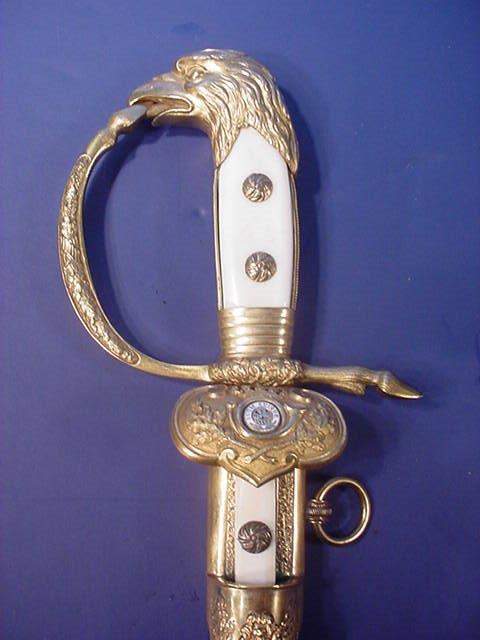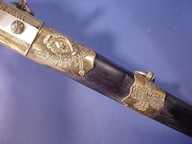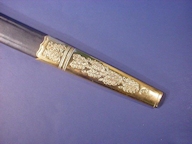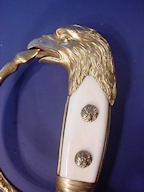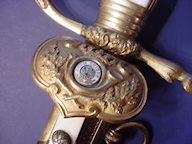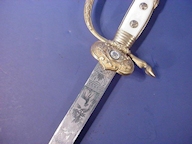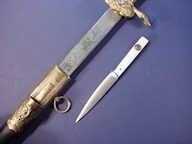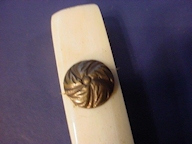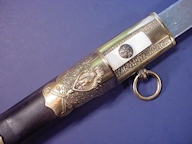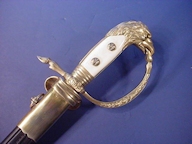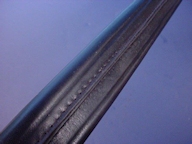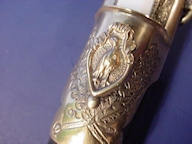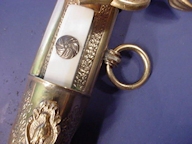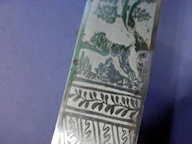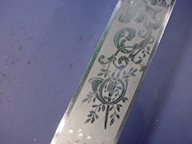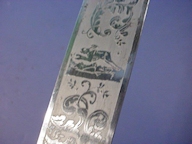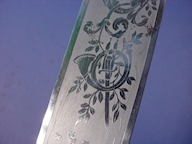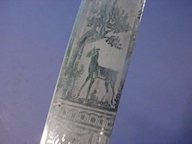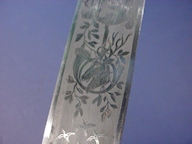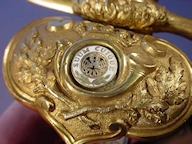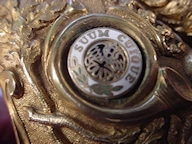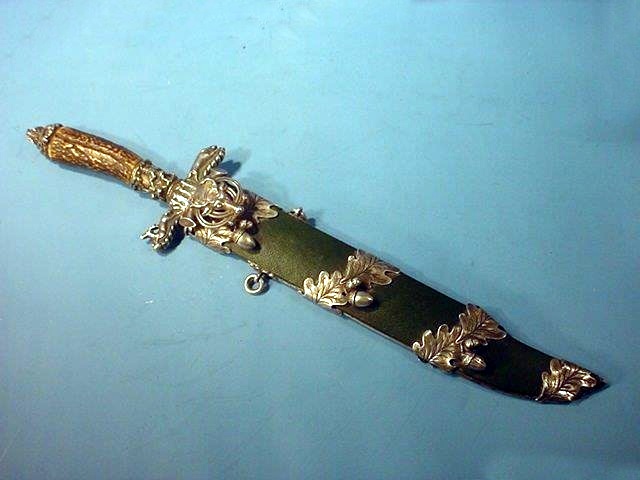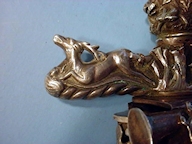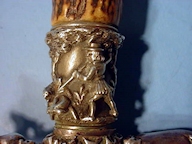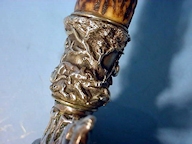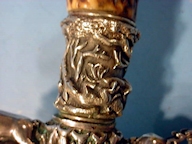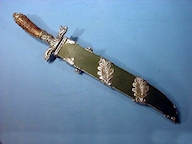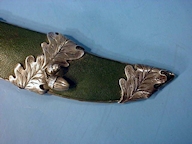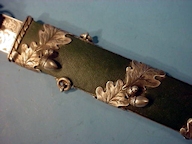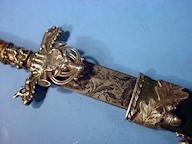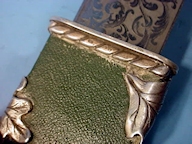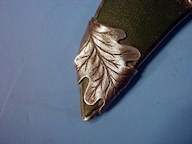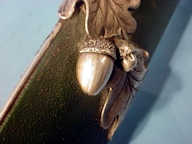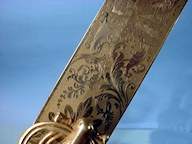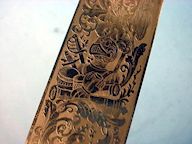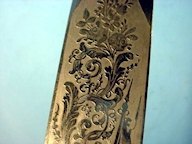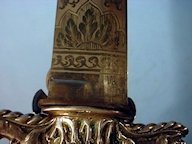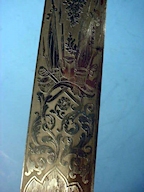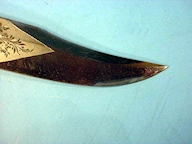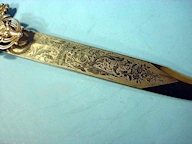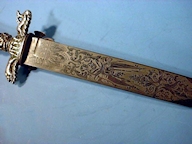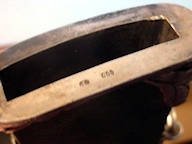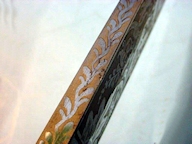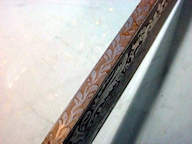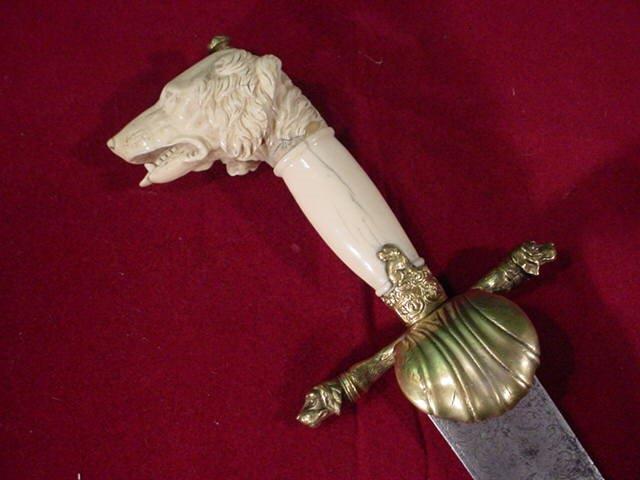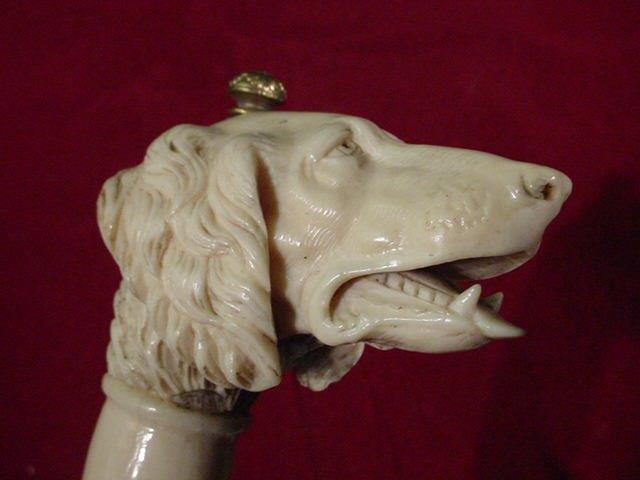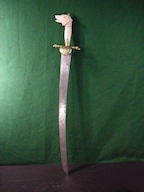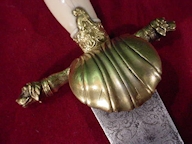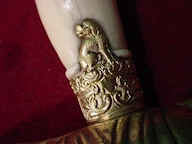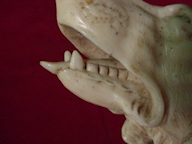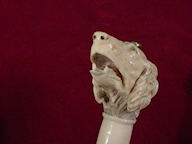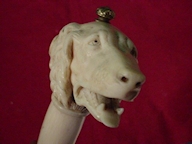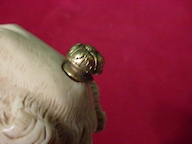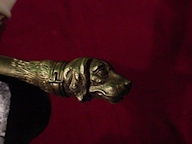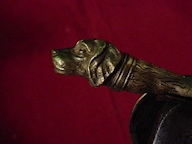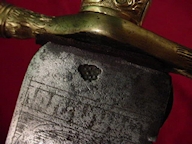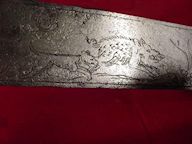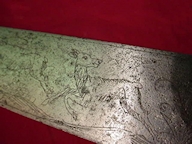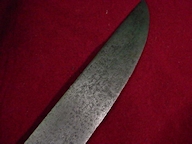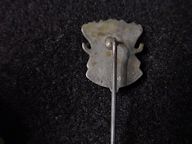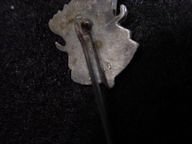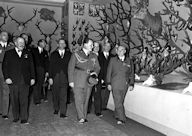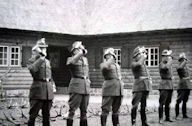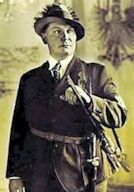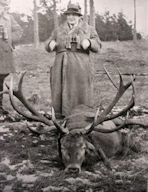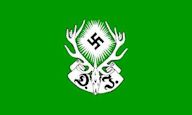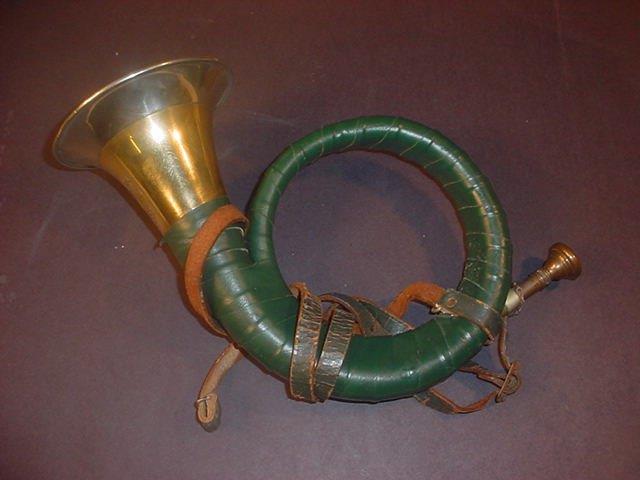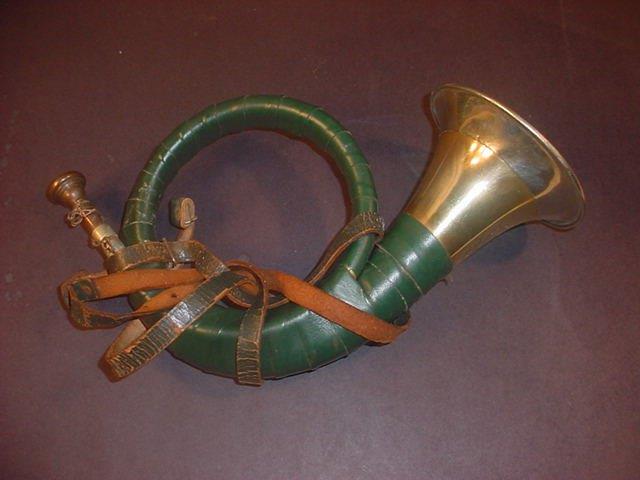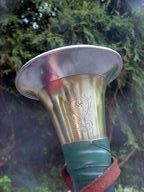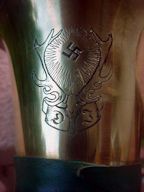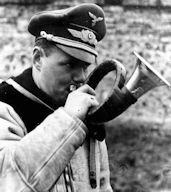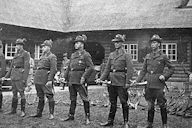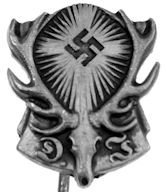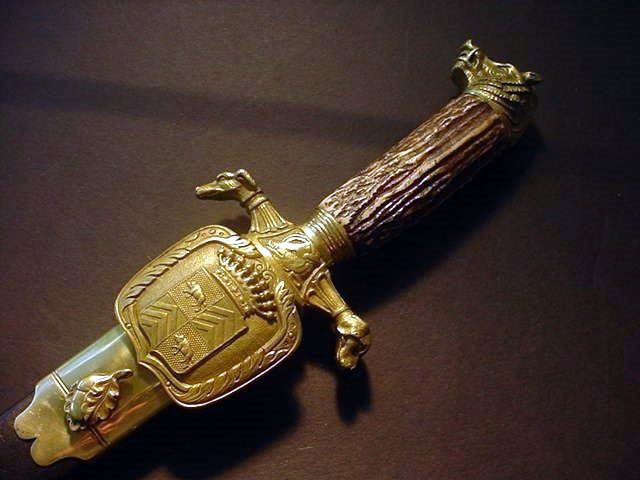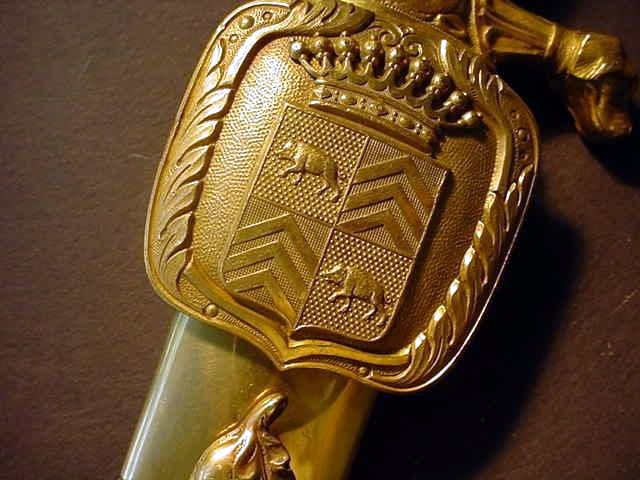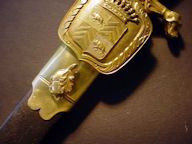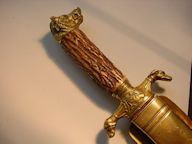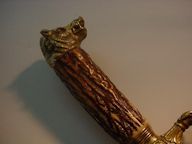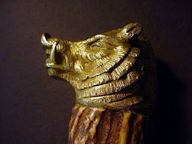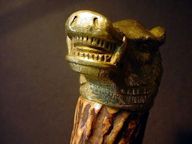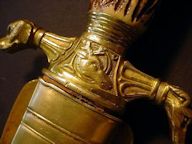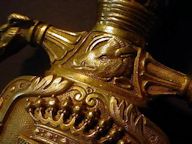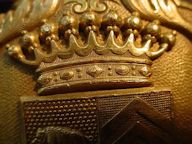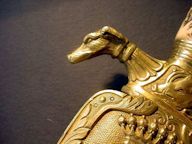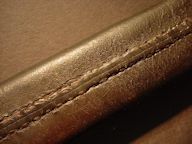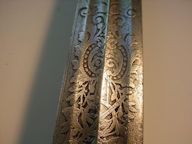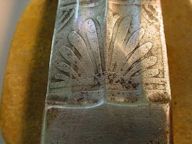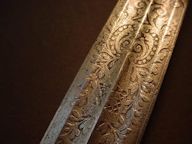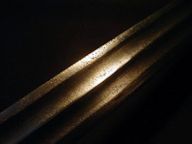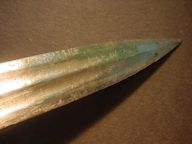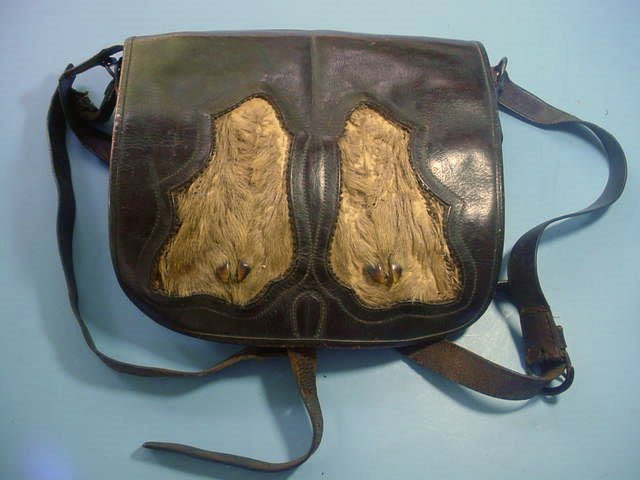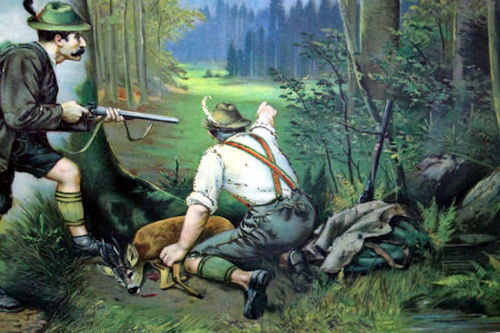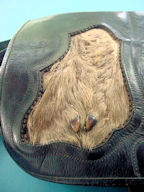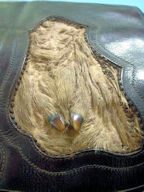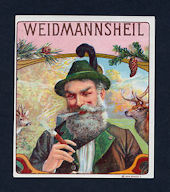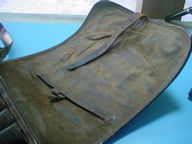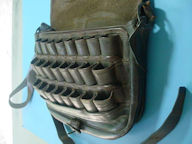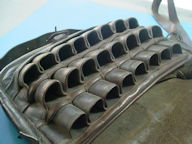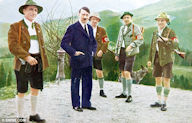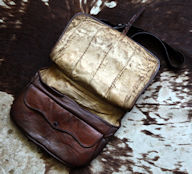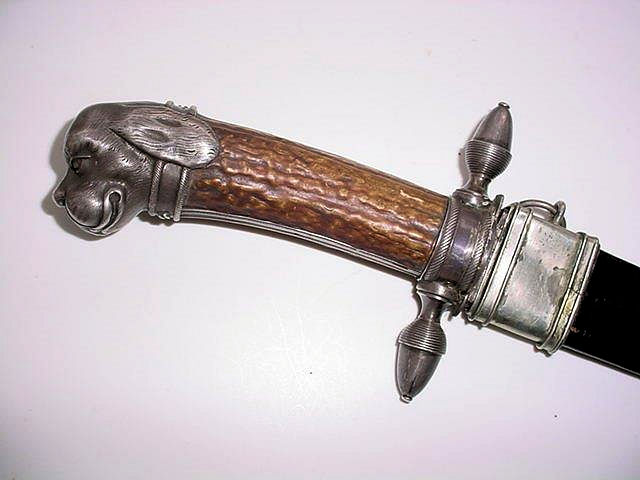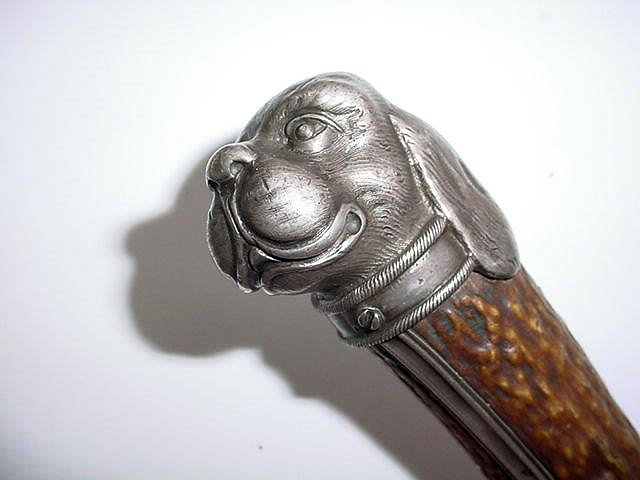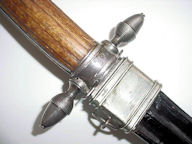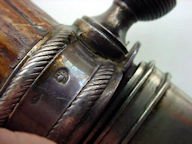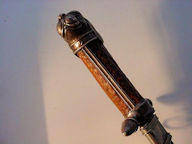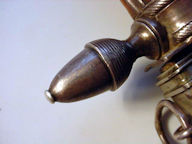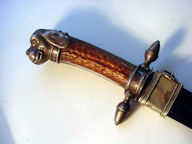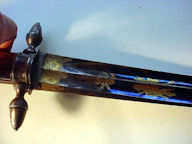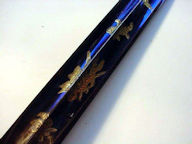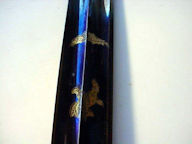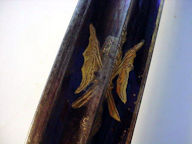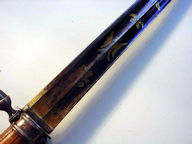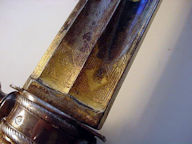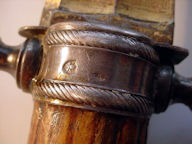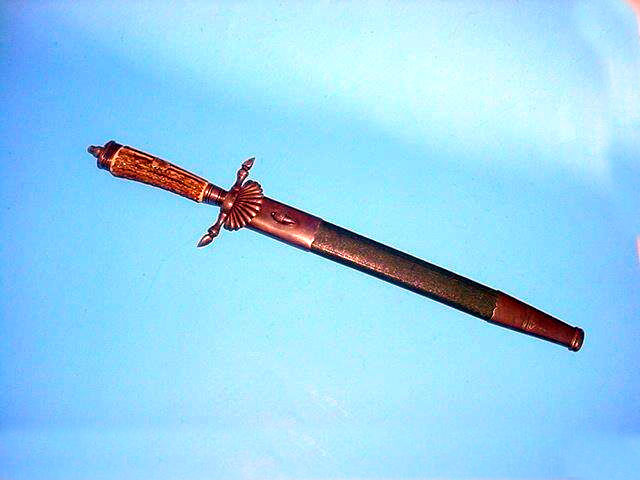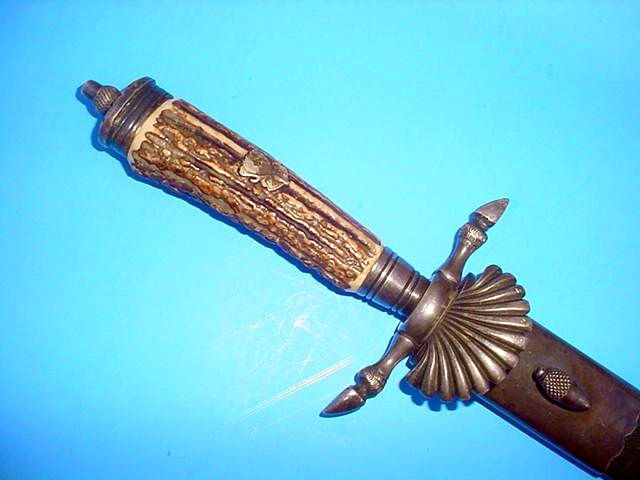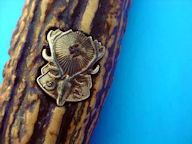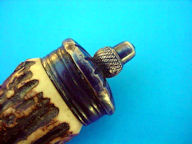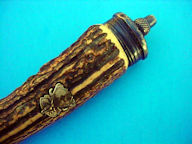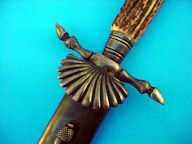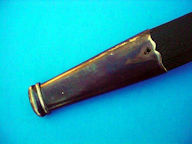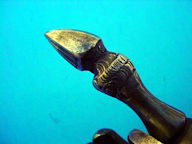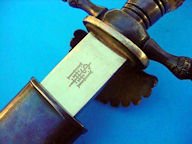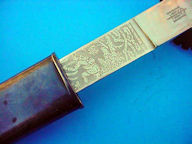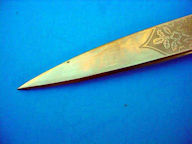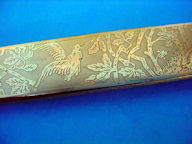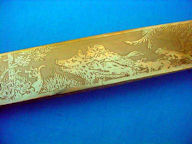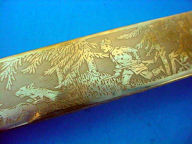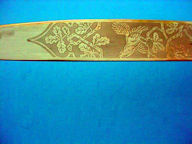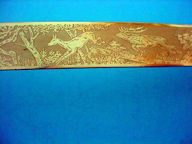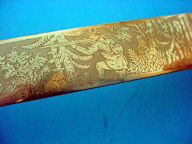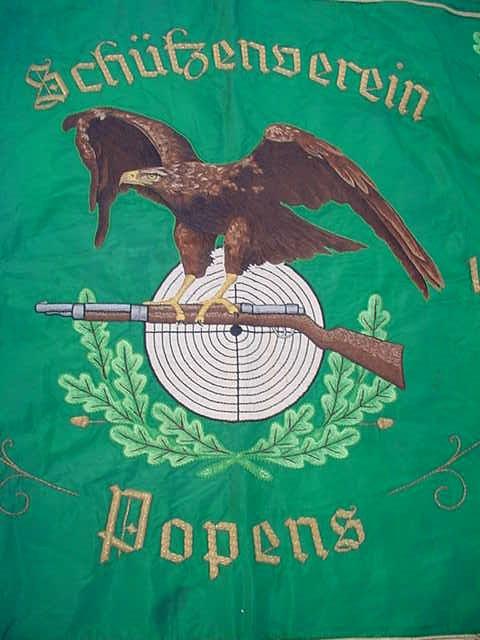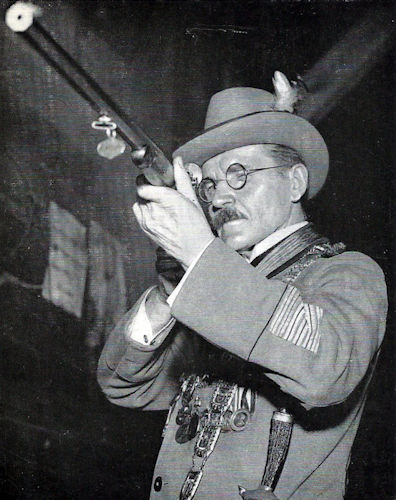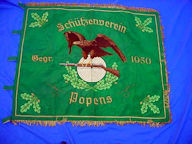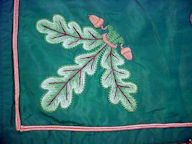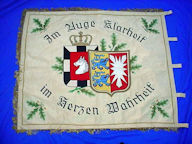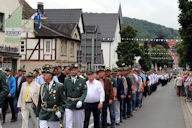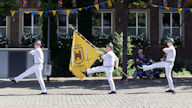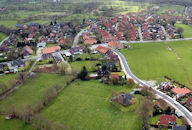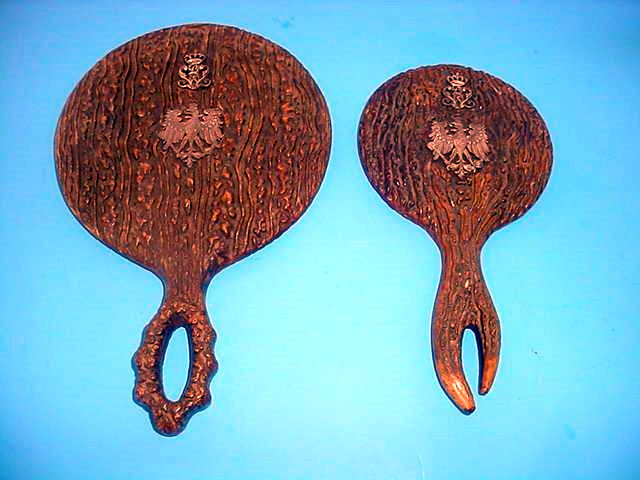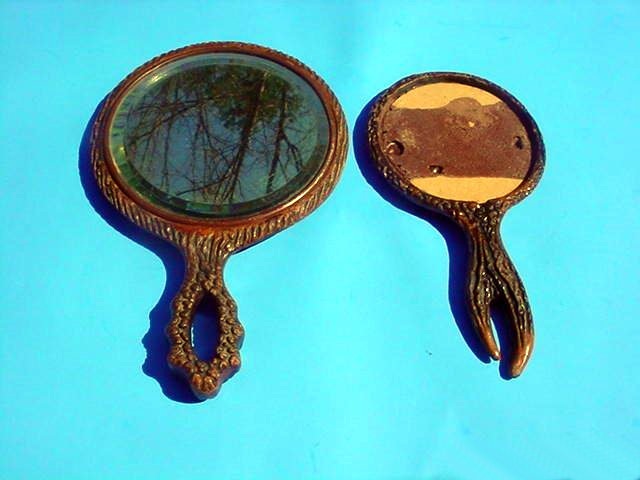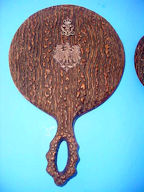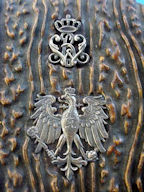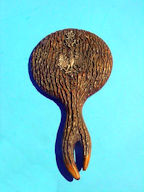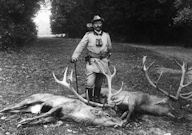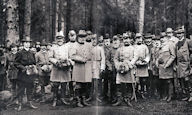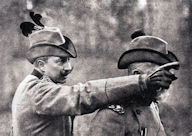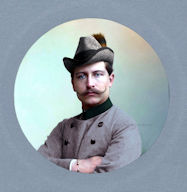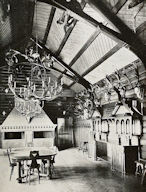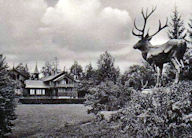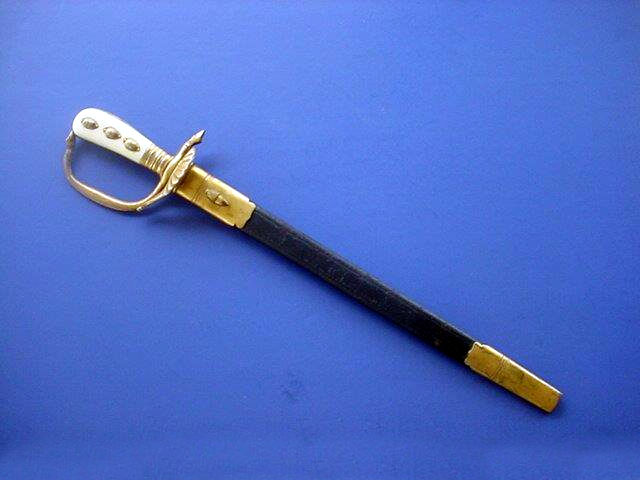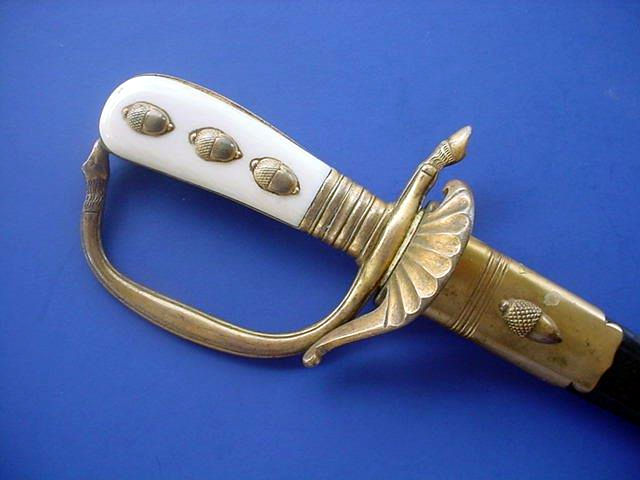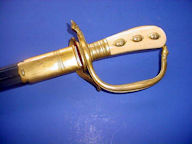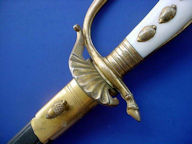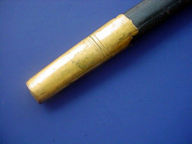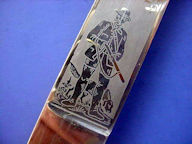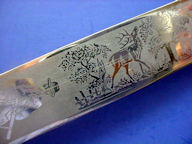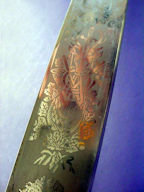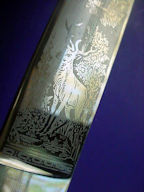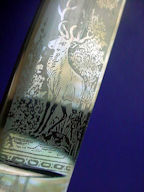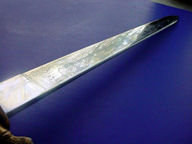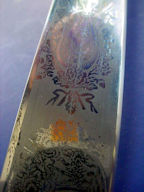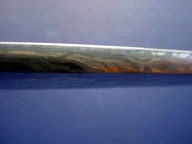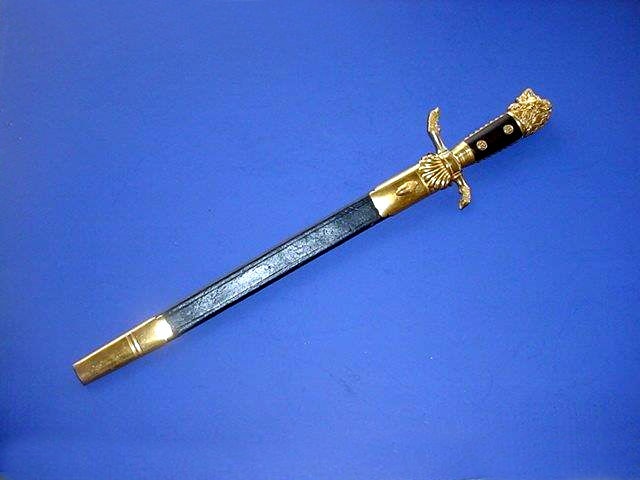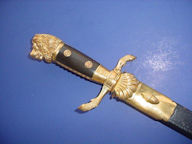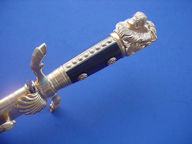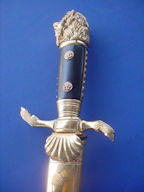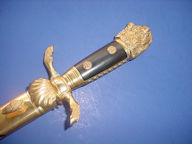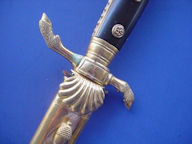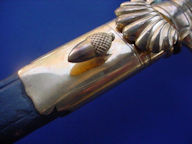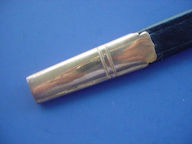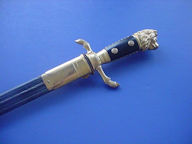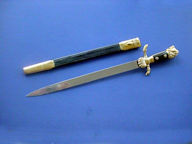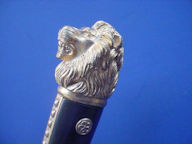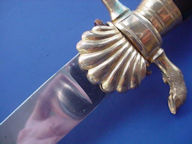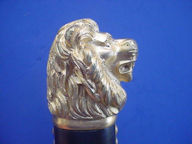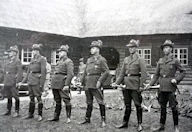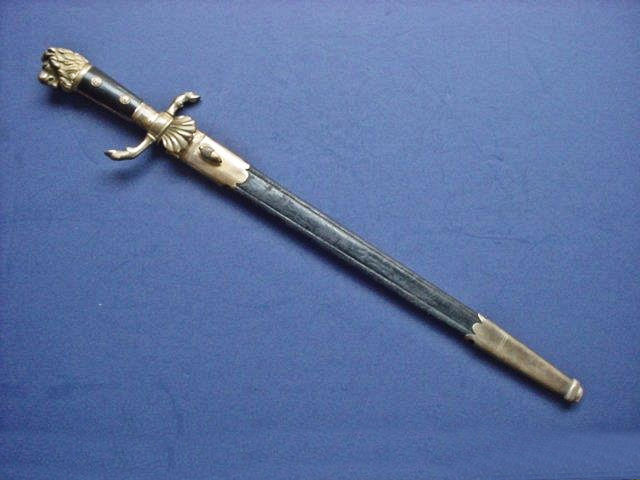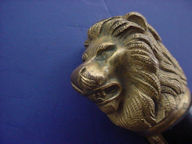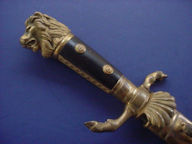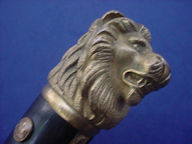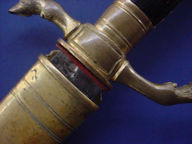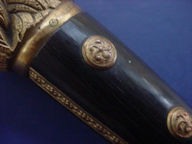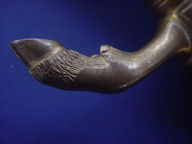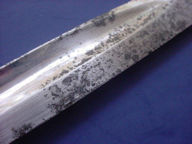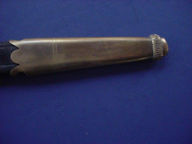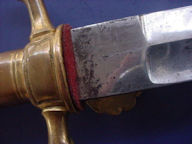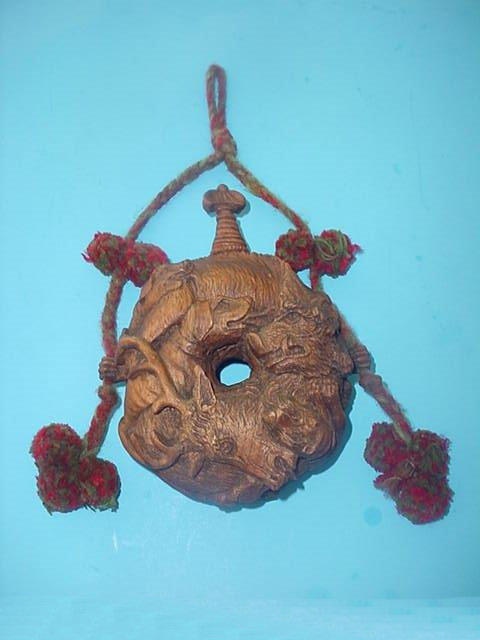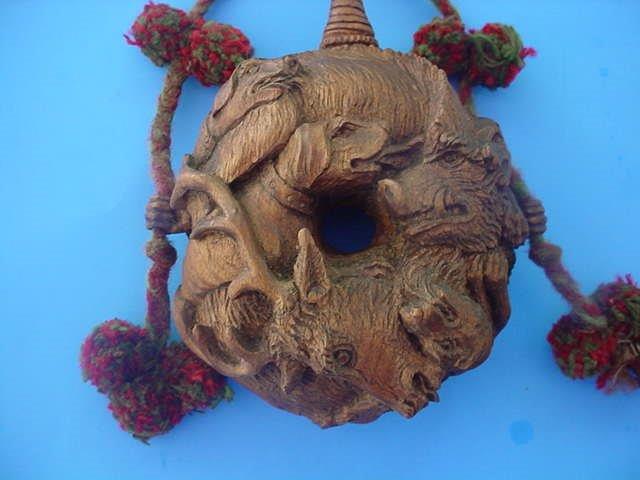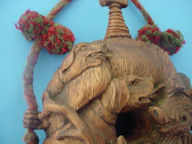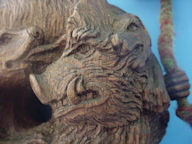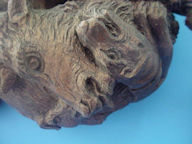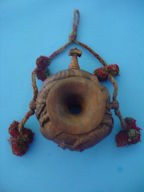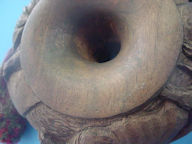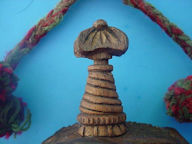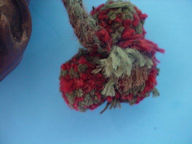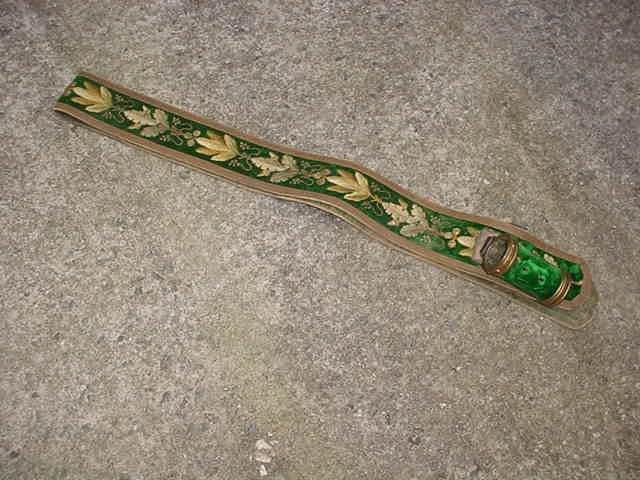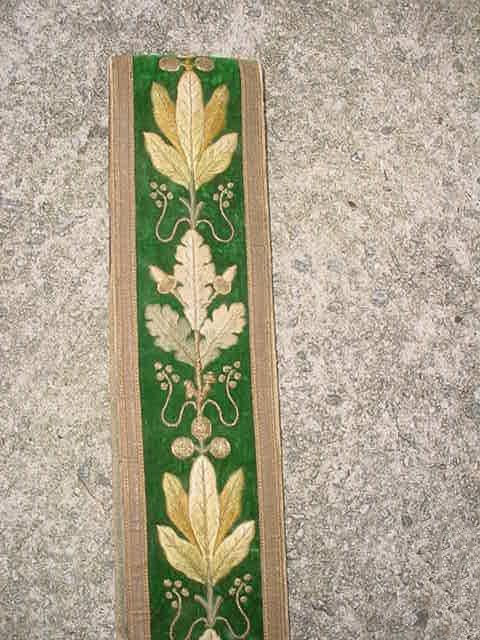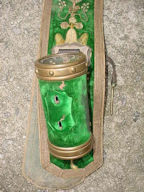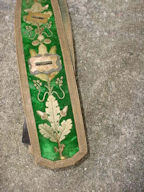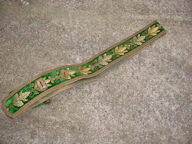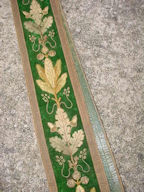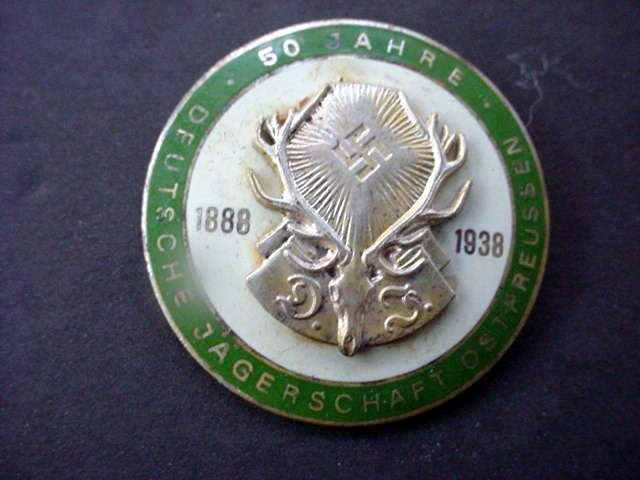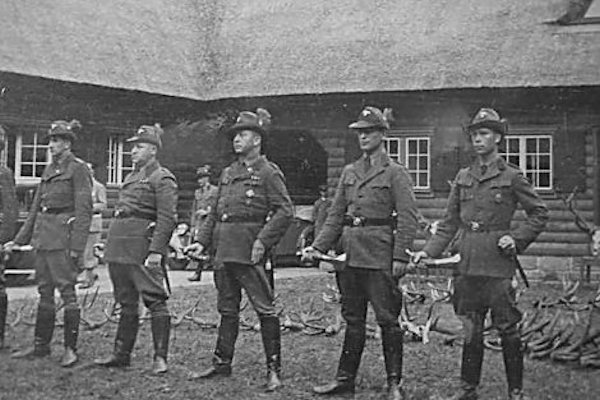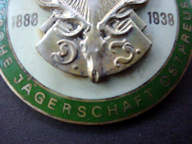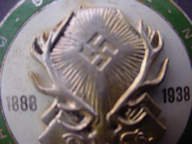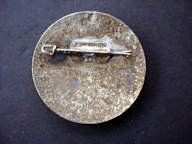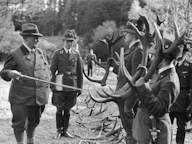|
Hunting and Shooting in Germany Page 8
| |||||||||||||||||||||||||||||||||||||||||||||||||||||||||||||||||||||||||||
Bronze Sculpture of Germanic Hunter (Item HUNT 8-4; BRONZEMET 2-4a; ART 17-10) |
|||||||||||||||||||||||||||||||||||||||||||||||||||||||||||||||||||||||||||
| DESCRIPTION: Amazing! No sooner had we called the magnificent bronze sculpture seen above at BRONZEMET 2-4 and lo and behold we procured this piece that completely rivals the Teutonic hunter above. We will call this one the “Germanic Hunter.” We said in the narrative above that we had never seen a better bronze sculpture than the Teutonic Hunter and to that point we certainly had not, until this stalwart huntsman came along. The work is all as good as the Henry Weisse sculpture and if I were describing it I could probably use almost the same wording and for sure this offered sculpture is also typical of the best of bronzes of the mid 19th century, when the art was at its highest point. This piece is signed P.L. (Paul Ludwig) Kowalczewski, 1865-1910, Berlin. He was a highly rated prolific sculptor, who enjoyed the spotlight among the most talented artists of his time. His sculptures bring very high auction prices. If you will Google the (Online Antiques Centre) under bronzes and sculpture you can see an art-nouveau bronze by Kowalczewski entitled “Filling the Buckets” and note that it brought 6,800 pounds. The size was just about the same as this bronze named "Germain" with the same patina as used in most of this man’s sculptures. The bronze is possibly the greatest of Kowalczewski’s works and is certainly realistic and historically correct in every detail. The piece stands about 14 inches high including the beautiful marble base; the bronze itself stands 12 inches high. The base is 3 by 4 inches wide. This is Alte Germania depicted just as it was. The warrior wears a horned headpiece as these ancient hunters often did when pursuing game. They did not wear such gear, however, while engaged in warfare. He proudly sports a necklace of bear claws that reminds one of almost the same sort of ornamentation worn by American Indian warriors.
In fact, with the exception that he wears a beard he looks very much like an early American woodland Indian. His weapons are a bow with quiver of arrows and a spear tipped with flint or other stone as the spear point. He stands with one foot resting upon a rock while peering with his hand upraised to shield his eyes from the sun while scouting for game; upon the rock is the artist’s signature. So now we have a second masterpiece in this desirable size; a treasure of the art of the western world.
Don’t let size dissuade you; the world’s most precious bronzes housed in great museum displays are seen to be this size, and smaller.
PRICE: $7,800.00 |
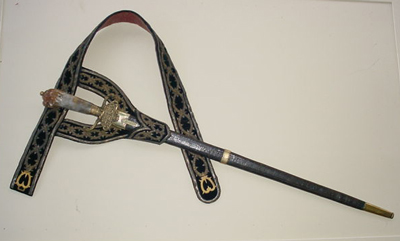 |
 |
Fantastic Find -- A Royal German Hunting Sword of the Early 18th Century (Item HUNT 8-5; KWEP 5-5) |
DESCRIPTION: Here is one of the most exquisite Hirshfangers we have ever seen whether in museums or private collections. Nothing in the Jadgd-museum in Munich would be better or more historically important than this piece. Absolutely breathtakingly beautiful, it is also quite long and could be considered a ‘Jagdklinge’ (hunting sword). It is 32 inches long with a blade 26 inches long. It remarkably features a grip fashioned from mutton jade or nephrite in a creamy white coloration (natural!) that shows some brown to Greenish hues and a lion’s head finial, typical of the very early pieces utilized by European royalty and aristocratic gentry when hunting. Although gorgeous in its presentation, it is obviously made for use in ‘the Sport of Kings”. A sword like this was usually used from horseback in hunt for the deer. The blade, although graceful, is nonetheless strong and effective but also quite elaborate with fine bluing down a quarter of the way along from the clamshell and cross guard. The hunting scenes featuring running deer, hunter, and hunting dogs are engraved and gold filled in the 17th and 18th century style. Could be early 18th century or even late 17th century. The workmanship and the style are indicative of this early period. The clamshell guard is the most elaborate one we have seen on such examples. It depicts the wild hunt of Diana the Huntress, daughter of Zeus, who is forever associated with wild animals and woodlands. Within the scene portrayed you can see Diana as she directs a Royal hunt with dogs and a mounted Walkurie type huntress pursuing game. The sword is also accompanied with a royal belt with special adaptation made to relieve and display the sword on festive occasions. These swords and hunting daggers were not only utilitarian tools of the sport but also items of great beauty that served as a sort of status symbol for the wearer who in this case may well have been a member of Germanic royalty. Jade was a precious commodity in those days of yesteryear, and ownership of articles that employed the use of such elegant pieces belonged exclusively and invariably to the wealthy or royal personages. (See the hunting dagger of Price Adalbert of Prussia offered separately.) Translucent emerald green jade and mutton Jadeite were and still are the most prized variety of the precious stone. This sword is in absolutely wonderful condition as is the scabbard that is of leather with brass mountings. The Buckler or belt is in great condition also and shows the finest of early embroidered golden bullion thread work. The design is reminiscent of thorny bramble bushes that would be found in the deep forest. The buckle fastener is in gilded brass in the shape of two heart-like figural adornments that fit together to fasten about the wearers waist. The belt is in a very small size and measures about 3 feet long. The sword with girdle or buckler makes for a wonderful and prodigiously historically important relic of a bygone age of regal omnipotence and luxury. PRICE: SOLD |
|
|
Plaque from the Deutscher Jägerschaft (German Hunting Association) (Item HUNT 8-6a) |
|
DESCRIPTION: The DJ was a public sporting organization under the direction and control of the National Hunting Master, Hermann Göring. The association controlled the hunting activities of all Germans authorized to shoot wild game. Its objectives were to further national game conservation and to teach Germany’s hunting enthusiasts the skills required in the pursuit of their pastime. Germany’s forest and fields have abounded in a wide variety of game animals and birds among which are stags, wild boar, rabbits, pheasants, and ducks. Today’s abundance can be mainly attributed to the strict regulations that were enforced by the Hunting Association and the Reichsjägermeister, Hermann Göring. The plaque is mounted on wood and measures 4 ¼ inches square. The medallion is 3 inches in diameter. On the back is the name of the hunter who won 496 points in the competition in shooting that won him this prize and the paper stamp from the trophy company that produced this honor prize. The plaque depicts the Saint Hubertus symbol of the DJ and the year 1937.
A beautiful and important prize.
PRICE: SOLD |
|
|
|
Magnificent (HUGE) Hunter’s Wooden Plaque (Hand Carved and Lettered) (Item HUNT 8-8; ART 17-18) |
|
DESCRIPTION: For all of you collectors of hunting-related art or even collectors of fine, wood carvings, this is for you! It is a beautifully executed plaque that undoubtedly hung in the home of a Jäger (hunter) or perhaps in a hunting lodge in Germany. The depiction is of the German game animal known as the chamois and is an excellent example of Germanic wood carving at its best. The animal is surrounded by a wreath of oak leaves from the tree sacred to the Teutonic people. The three-dimensional emergence of this artistic achievement is incredible. The plaque is large measuring 43 x 20 inches. The Inscription Inscribed in indented carving are the words: “Das ist des Jägers Ehrenschild, das er beschützt und hegt sein Wild, Waidmännischjagt wie sichs gehört den Schöpfer im Geschöpfe ehrt .“ Roughly (quite roughly) translated for meaning: “The forester’s sign of honor is such that he protects and preserves the game and it is his position that he listens and obeys the high command that there is meaning, dignity, and importance to every creature and living being.” (Editor’s note) If the entire world could remember this equation then peace would truly rule the planet! The plaque is generally in good shape with one chip out of the right-side top of the framing. All the artistic carving is perfect including the chamois and the oak-leaf configuration on the right side. This is a beautiful significant piece of art from what was a better age. PRICE: SOLD |
|
||||||||||||||||||||||||||
|
Deluxe Hunting Cutlass Attributed to the Kaiser’s Guard Regiment—Das Regiment der Gardes du Corps (Item HUNT 8-9; GDUCORP 1-9; ANTWEP 2-29) |
||||||||||||||||||||||||||
| DESCRIPTION: Here is a breathtaking example of a royal hunting weapon of the Prussian nobility. Unlike the much smaller examples that have a dog or a boar motif pommel, this one features a bold and handsome Prussian eagle as its crowning feature. All the metal parts of this piece are heavily gold plated. The grip of the weapon is crafted in white bone, as is the grip of the skinning knife. The eagle head looks a lot like the eagle motif on a Gardes du Corps helmet and we feel we can ascribe this wonderful weapon to that regiment. This, of course, was the famed regiment whose function was to be the personal guard to the German Kaisers of the Prussian Hohenzollern dynasty. Further evidence of this can be seen on the clamshell guard where you can see an enameled plate with the symbol of the Gardes du Corps on it surrounded by a hunting horn, oak leaves, and acorns, and this is surmounted with the Prussian crown of the empire.
The crown at this time—mid 1700s to the late 1800s—was only seen on royal articles: such things were closely regulated. This is no peasant piece. It is 100-percent either royal or at least owned by the officers of the elite GDC. The bone grip of the main cutlass and on the skinning knife are decorative roundels that are described as Sonnenrad (sun wheels). This was known to be another symbol of the various guard regiments. This weapon measures 29 inches in its scabbard with a blade measuring 21 inches long. The blade is quite beautiful employing various etched hunting scenes with stags, boars, game birds, rabbit, wolf, hunting horn, and many wonderful floral designs. On the backside of the blade (about 8 inches of it) are in much-used shape as these Hirschfänger were not only beauty contest participants, but were actually used on the royal hunting sport. That usage does not merge into but a tiny bit of the floral etching. All in all, the entire piece, except for this blade usage that really does not at all detract from it, is in practically mint condition and is nothing short of prodigiously spectacular!
PRICE: SOLD Germania International will not ship any item that contains any animal parts to any country where such items are prohibited! |
|
|||||||||||||||||||||||||||||
|
Ausstelung Hirschfänger (Exhibition Hunting Knife) (Item HUNT 8-10; ANTWEP 2-30) |
|||||||||||||||||||||||||||||
| DESCRIPTION: This is without a single doubt the most fantastic edged weapon we have ever laid eyes on. It is seen here just dripping with Germanic Hochkunst (high art,) although it looks like something that would have been the property of a king or emperor (although it just might have eventually been such!). It started life as a special exhibit item from a maker in Solingen, Germany. The fact that it has no maker’s mark is indicative of that !!! Once a year artisans in the “city of blades” submitted the absolute greatest and finest of their work to be exhibited in intensive competition with the hope of winning first prize. This contest was open to all the various companies that manufactured edged weapons and only their handmade items were allowed to be exhibited. Also, the individual nonaligned knife makers and blacksmiths that specialized in bladed objects also were encouraged to exhibit their masterpieces and it was usually those artists who would win first place. Undoubtedly, this particular masterwork would easily have been the victor. If anyone were to visit the Deutsches Klingenmuseum near Solingen they would actually be hard pressed to see an example of a grandiose hunting knife that could even start to rival this one that we offer here. This knife is definitely unique (one of a kind) and for sure the product of an individual maker and surely the only one in the entire world and it’s a pretty safe bet that you surely see here the winning entry. In all our long experience in this field we have never encountered anything as stunningly beautiful as this piece. It is also the epitome of Germanic beauty with very extensive high-relief oak leaves and acorns all individually joined to the scabbard in pure 800 silver. The 800 silver mark can be seen twice on the parts along with the half moon and crown. These were the mandatory marks that are required to be used by a maker of items containing silver. This was a regulation of the government minting office for silversmiths. The blade on this piece is interestingly Bowie shaped giving credence perhaps to the German infatuation with the romantic weapons of the American West. The blade is also a treasure in itself with heavily engraved floral and armament motif—knights, helmet, pole arms, swords, cannon, flags, lancers, armor, rifles, bayonets, etc. The floral sections are particularly gorgeous! The clamshell guard bears a stag’s head entwined with hunter’s horns with openwork. The crossguard features a running stag on the left with a boar running on the right. The upper guard support has a hunter thrusting his spear into a wild boar that is beset by hunting hounds. The pommel shows another boar being attacked by hunting dogs. The grip is formed with a stag’s horn. The back of the blade has more oak-leaf trim. There is no signature on the piece and that is the point that proves the exhibition aspect of this magnificent knife. The exhibition rule was that items put up for exhibition would never be marked with maker signatures so that the exhibition judges would not be biased toward any participant regardless if it were a company or individual. The knife is big–a little over 20 inches in its scabbard and the blade measures 13 inches. The scabbard is made of leather under all that silver and it is in a beautiful green hue with no seam showing. We will only be judged repetitive if we say again that this is probably and possibly the most incredibly matchless item we have ever offered, and certainly the most beautiful!
PRICE: SOLD |
|
|
Magnificent Hunting Sword of the 18th Century (Item HUNT 8-13; ANTWEP 2-34) |
DESCRIPTION: This is a very unusual hunting sword attributed to royalty or, at least, to a very wealthy member of the landed gentry. The piece is German and from the looks of the blade it seems to be from at least the early 1700s, or possibly even in the mid-to-late 1600s. The most unusual thing about it is the fantastically detailed head of a hunting dog carved into the bone finial or pommel. The swordsmith who carved this magnificent hound had to be an absolute master of the craft. The eyes, the nostrils, the great ears, and especially the teeth and tongue are prodigiously lifelike. The hair of the dog and his ears are especially noted: The breed very well could be the famed large Munsterlander that was used often in medieval hunts. The grip is also carved in fine white bone--indeed rare--and were purchased only by the wealthy. Between the bottom of the grip and the crossguard and clamshell fixture is a brass ring that has a hunting dog perceived as sitting on his haunches. Additionally, at each end of the crossguard are the heads of hunting hounds and the blade scenes are depictions of the hunt with dogs. So, with a bit of extrapolation license, I will say this is undoubtedly a Jagdschwert (hunting sword) whose main purpose was to be used in the hunt for Wildschwein (boar) and in a boar hunt it was usual to hunt while on foot employing a boar spear and a side weapon. This was a most dangerous sport as a boar is a formidable beast and have been known to attack and kill many stalwart hunters with their razor-sharp tusks. So, the side weapon had to be a stout piece capable of slaying quickly this often huge and fiercely angry beast. The blade on the weapon offered here is quite thick and heavy and reasonably capable of the task as long as the man who wields it is strong and maneuvers well. Possibly it is the most dangerous of all sports and not for the feeble. The blade as we indicated is engraved with hunting scenes namely with hounds hunting boar and chasing deer. The sword is almost 30 inches long and the blade is 24-1/2 inches long. Here is an antique weapon worthy of being in the hunting museum in Munich—it is that fine!, and is also historically important. PRICE: $18,500.00; this is a museum piece extraordinaire! This antique weapon is well over 300 years old. |
|
|
|
German Hunting Association Stickpin in 800 Silver (Item HUNT 8-14; PINS 8-23) |
|
DESCRIPTION: Here is a special stickpin for the (DJV) Deutscher Jagdverband (German Hunting Association). This was the organization first established by Hermann Göring, who was the Reichsjägermeister, or Chief Hunting Master in National Socialist Germany. The insignia is of a stag’s head with the swastika (symbol of light) that sits before a pattern of the sun’s rays symbolizing the Machtergreifung (The seizure of power) of the N.S. Party. A ribbon below the stag’s head has the legend “D.J.” for [Reichsbund] Deutsche Jägerschaft (German Hunting Society from 1934 until 1945). The Reichsjägermeister added these letters to the insignia after he had become its chief. The stag’s head is symbolic of the legend of St. Hubertus (look him up on Google or Bing, or use ‘Search Germania’ on our homepage for further information.) The stickpin is about ½ inch tall and ½ inch wide and marked “800” for the silver content on the backside. It’s beautifully detailed and is one of the prettiest stickpins of the Third Reich.
PRICE: SOLD |
|
|
|
|
|
Hunting Horn from the Deutscher Jägerschaft (Hunting Society) (Item HUNT 8-15) |
|
DESCRIPTION: Here is a truly rare Third Reich musical instrument; the official Jägdhorn of the German Hunting Association first formed by Reichsjägermeister Hermann Göring in 1934. The primary objective of this association was to advance wild-game conservation through the necessary enforcement of the National Hunting regulations. Göring was the natural pick to head this group as his favorite pastime was stalking game in the beautiful and plentiful German forests. It was one of the finest and most effective of such organizations in the world and was a prime example of such, and the regulations that were proffered are followed even today as first enacted and practiced in the Third German Reich. The horn is a part of old Teutonic tradition. The ancient German tribes always blew the “triumph horn” to begin a hunt and blew it when the hunt was deemed successful. The hunting call at the start was called “Horrido” and when the game was taken the call was “Hallali.” The symbol engraved on the surface of the horn is known as the Stag of St. Hubertus and it embodies the depiction of the noble animal with a swastika shining with sun rays from the space between the antlers and the letters “D J” in a scroll beneath. The letters stand for Reichsbund Deutscher Jäger Verein or National German Hunting Association. These horns were usually played by the band at hunting ceremonies and were very meaningful to the association. They have been found with the “D J” insignias separately soldered in metal to the horn and that was the usual way. This one was probably the personal property of an association leader or a hunter who thought enough of the item to have a special one ordered. The engraving is exquisite and the entire horn is in beautiful condition with all its original straps. The straps are a bit worn. Why? Because the horn was used, but not abused. This is a very rare Third Reich item of great historical importance. PRICE: $1,950.00 (Who ya gonna call? Germania International!) |
|
|
|
Most Unusual Hunting Sword of the Late 19th Century (Item HUNT 8-16; ANTWEP 4-10) |
| DESCRIPTION: Here is one of the most unusual Hirschfänger (literally: deer catcher) that we have ever seen in collections or even in the hunting museum in Munich. It can easily be termed a hunting sword rather than a hunting knife. It is rather long measuring about 30 inches in its scabbard. The pommel features a fierce-looking boar’s head with his teeth and tusks bared. The crossguard has another boar’s head in the center and on the other side an antlered stag. At the ends of the crossguard are the sculpted heads of two separate breeds of hunting hounds (right and left). The grip is crafted in stag antler. The most exciting and unusual feature of the piece lies in the clamshell languet. It bears a crest or coat of arms surmounted with a crown. This royal diadem looks as if it might be the style worn by the Dukes of Mecklenburg-Schwerin or possibly it might be a form crown of the Austrian Hapsburgs. Under the crown is a Wappen (crest) with boars again, and heraldic bars. Because of the crown usage, this piece probably is an item for the Royal Hunt. The question is this: If indeed it is Royal ownership, would it have belonged to a king, prince, duke, or count??? That there is a royal connection to the weapon, there is no serious doubt. In those days of old, no one would dare to have such a sword crafted with a crown unless he merited it with royal heritage. The blade is 23 inches long and is obviously from the late 19th century or could possibly be earlier. It is no shrinking violet; it’s made for the kill!, not just for show at hunting banquets. It has strong double blood grooves all the way to the end. It is obviously constructed with the hunting of wild boar as its purpose. There is some floral engraving on the blade a third of the way up from the start of the blade at the crossguard (both sides). We believe most firmly that this piece was made to conform to the wishes of a notable who enjoyed “the sport of kings.” Who knows? He indeed might well have been a king? The scabbard is fitted with brass fittings. The leather is fine considering its age with no obvious breaks, cracks, or bends and appears to be original to the sword. The little acorn that would accept the carry frog is beautifully designed. There is no signature on the piece (not unusual). This is an utterly magnificent weapon for a refined gentleman of royal blood.
"
PRICE: $4,500.00 TRADED AWAY; NO LONGER AVAILABLE. |
|
|
|
|
German Hunting Shell Bag (Item HUNT 8-17) |
| DESCRIPTION: This is a very rare accoutrement for the German hunter. It is a covered pouch or bag that houses the sportsman’s shotgun shells. The pouch is constructed in the finest front quarter hide and it opens to expose 24 individual loops for the 12-gauge-shotgun shells that fit snugly within. The pouch is in great shape. The front flap cover has two identical panels, each being about five inches long that have imbedded the hide parts of a small game animal (perhaps a roe deer). The hooves of this animal are showing, as well. The pouch measures 9 ½ inches across the front flap and is in very good shape except the shoulder straps might have to be adjusted and one strap is in need of a little repair. The age of this item has not been positively determined but we pretty much believe it is from the 1930s. It is probably a unique item considering its sporty look and decoration and undoubtedly was expensive in its day and probably purchased by landed gentry or gentlemen of means.
"
PRICE: SOLD |
|
|
|
Gorgeous Dog-Head Hirsh Schwert (Item HUNT 8-18) |
| DESCRIPTION: Here is one of the nicest hunting swords we have encountered in the style actually used in the hunt. Words just don’t do it justice. The landed gentry of Germany loved the chase and they demonstrated their zeal in the special equipment that they specially designed with personal pride and flair for the sport. The items that they most adored were the daggers and swords they owned. A man’s persona would often be conspicuously displayed with pride or, in this case, affection for the hunter’s next-most-valuable asset, his dog. In this case the owner of this Hirschschwert portrays his best friend on the pommel of the sword in fine silver. Actually, all the fittings on the piece are in silver and the grip is in two Hirschhorn (antler) panels and the crossguard has a silver-acorn motif. The dog is shown to be a happy fellow with a great smile on his pretty face. The scabbard is in very fine condition with the center-banded ring intact as is the upper throat. The scabbard tip or boot is silver and decorative. The strong scabbard has a fluted and raised centerline to accommodate the fluted blade. The blade is especially fine both in beauty and design. It has as I have said a fluted centerline that stands out in relief. This shows us that this piece although outstandingly gorgeous is also made for the huntsman’s purpose. The sword is incredibly long at 32½ inches in its scabbard. The blade is 26½ inches long. This is the type of weapon that the wealthy used when hunting from horseback or when entering the bush for the wild boar. We would say that a piece this magnificent would most likely date in the mid-18th century about the time of Frederick the Great of Prussia. The style of the blade tells us this when we look at the gold escutcheons on this blade laid over the wonderful blued panels. There is no signature on the blade probably because the owner wanted to share his designing skill with nobody at all! All in all, a vastly superior huntsman’s sword.
"
PRICE: SOLD |
|
|
|
German Hunting Association Dress Dagger in Mint Condition (Item HUNT 8-19; THIRD ) |
| DESCRIPTION: Here is an almost-mint example of one of the prettiest daggers of the Third Reich. (Hermann Göring launched the German Hunting Association.) This one is a bit unusual in that the pommel, or crown, has above it an acorn configuration. The insignia which is the St. Hubertus stag with swastika is mounted on a little bit of a different angle. We presume that it ties in with the way that the original owner ordered it (something to do with his uniform) so the insignia is mounted a bit to the right of the usual position. This piece has never even been cleaned or polished and has the original darkened finish. The grip is of course a very handsome stag antler piece. The crossguard is comprised of extended deer hooves and the clamshell is the normal type used with Hirschfänger. The acorn that would accept the frog when worn is there. The staple-like retainer at the bottom of the scabbard throat is missing, but the scabbard throat is not affected. The cloth buffer between the blade and the crossguard is there. The blade is 100 percent mint by Horster in Solingen. The beautiful pattern on the front side shows a hunter with his dogs in pursuit of a wild boar. On the other side there is a hunter firing at two elk and above this is a partridge. Even the top edge of the piece shows a pattern of oak leaves. Because of the acorn at the top of the pommel and the general treatment of this piece, we think it is a deluxe model. Certainly, you would never find one in better condition. Length of scabbard is about 21 inches. The scabbard leather is at 100-percent immaculate condition.
"
PRICE: $1,980.00 |
|
|
|
Wonderful German Schützenverein Banner (Item HUNT 8-20) |
| DESCRIPTION: Here is one of the most beautiful “marksmen’s club” banners that we have ever encountered. It’s dated “1950”—five years after the cessation of World War II. This certainly is evidence of the strength of the German people who lifted themselves up from the devastation and horrible aftereffects of the war. It was about this time that German sports clubs were granted permission to have organized shooting events. Notice the extremely fine workmanship, especially in the body of the eagle. The obverse side of the banner has the eagle, a target, and the original date of the founding of the club in the town of Popens, Germany, in 1950. (Popens, in Lower Saxony, is located about 250 miles west of Berlin.) The size of the banner is 48 x 39 inches. The condition can only be described as “near mint.” The reverse side shows the arms of the village and has the words (translated) (“In the eyes, clarity; in the heart, truth.”).
"
PRICE: $1,500.00 |
|
|
|
Two Dresser Mirrors from Kaiser Wilhelm’s Royal Rominten Hunting Lodge (Item HUNT 8-21; WILHELM 9-24) |
| DESCRIPTION: The electoral Hunting Lodge of Rominten (Kurfürstliche Jagdbude Rominten) was first mentioned in historical records in 1572. In 1674, a new lodge was built, as the old one had fallen into disrepair. By the late 19th century, neither lodge was in existence; all that remained was a small forestry workers' settlement, a tavern and a forester's office.
Prince Friedrich Karl of Prussia rediscovered the Rominter Heath as a potential hunting ground. Kaiser Wilhelm II first visited the Heath in 1890 and decided to build a Royal Hunting Lodge at Theerbude (lit: Tarhut). The building was constructed by Norwegian workers to a Norwegian design, following plans drawn up. The materials were also imported from Norway. The Kaiser first stayed at the new lodge in autumn 1891.
A small Norwegian Stave Church-style chapel dedicated to Saint Hubertus (the patron saint of hunting) was built in 1893, and Theerbude was renamed "Kaiserlich Rominten" (Imperial Rominten) on 13 September 1897. Over the following years, a youth hostel and an orphanage were built, and the village became a popular tourist resort. An "Empress-wing" was added to the lodge in 1904.
Wilhelm II spent several weeks each fall at Rominten. This lodge had the distinction of being the place where he and his ministers made the most important decisions regarding improvements to the navy and ship-building. Government ministers would travel out to the lodge from Berlin. Most of Wilhelm's time at Rominten, however, was spent hunting. He and his entourage would rise at 5:00 each morning and be driven out to the forest. Standing on special platforms, they would wait for herders to drive deer and elk toward their positions. From 22 September to 2 October 1913, Wilhelm II visited the lodge for the last time. In his 23 years of hunting on the Rominter Heath, he had brought down 327 deer.
After World War I, the Lodge remained the private property of Wilhelm II, although the exiled Kaiser would never return to Rominten. In September 1933, Wilhelm refused to allow Hermann Göring to stay in the lodge; Göring subsequently built his own Reichsjägerhof Rominten just a few miles away, with a game reserve extending nearly 100 square miles (260 km). After Wilhelm's death in 1941, Göring forced the heirs to sell the Rominten Hunting Lodge to the State of Prussia (of which Göring was Minister-President) for his own use. PRICE: SOLD |
|
|
|
Imperial Forestry Cutlass (Item HUNT 8-22; ANTWEP 4-26; KWEP 5-16) |
| DESCRIPTION: This imperial forestry cutlass is equipped with gilded brass mounts. The hilt has the usual "D" guard that ends in a deer hoof at either end. There is a lined ferrule on the piece, as well as a fine clamshell. The clamshell is the style with an elongated "foot" projecting out to the left. The white-bone grip plates are the deluxe, extra-cost type. They are in perfect condition, with fine veins in the surfaces. The grips are fitted with three acorns, each with a cap and a stem. The scabbard shell is constructed of black leather that remains in excellent condition, showing little age. It has the standard decorative edge lines and is sewn up the rear. The scabbard mounts are of matching brass, having scalloped edges where they meet the leather. The upper mount is equipped with a long acorn lug designed to retain a hanging frog. The 16-inch blade is etched on both sides; it remains clearly bright and has no pitting. The animals and etching on the blade are in practically unused, mint condition. The pictorial etching begins with a hunter’s holding a shotgun. Next is a stag and a deer in a forest glen, winding up with a deer head set atop a hunting bag. The reverse etch features a large stag, a scene of a hunting dog tracking a couple of foxes under a log, and ends with a stag and doe. The obverse of the blade is marked with the king and knight trademark used by W. K & C, dating the piece to the beginning of the last century. There is a purple-felt blade buffer in place. This is an excellent cutlass; we would have to say this is the very finest senior forest cutlass we have ever had or seen in many years.
PRICE: $1,295.00 |
|
|
Bavarian Forestry Official’s Dress Cutlass (Item HUNT 8-23; ANTWEP 4-27; KWEP 5-17) |
| DESCRIPTION: Here is a lion-pommel dress cutlass. Over the years a few of these have shown up; in fact we had one given to us on consignment and you can see it at (HUNT 2-3 on page 2 in Hunting and Shooting in Germany). Since then, we have learned some facts about these pieces. Thomas Wittmann also shows one on page 287 of his book Collecting the Edged Weapons of Imperial Germany Volume 1. This one, unlike the one we had at HUNT 2-3 of our site, is in much finer condition (as near to 100 percent excellent). Bavarian Forest wardens and other hunting officials carried these Hirschfänger on dress occasions. The Bavarian lion at the top gives these a uniformity not seen on commercial Hirschfänger. The grip plates are constructed of black horn material. The blade is unsigned as per usual with governmental-issued weapons. The piece is measured at 21 inches overall with a blade at 16 inches long. The blade is in practically mint condition and brilliant. The throat and boot on the dagger are still in wonderful condition. The crossguard is formed in the shape of deer hooves while the clamshell covers part of the upper throat. These Bavarian lion-pommel pieces when found are usually in quite worn condition. This one is the exception and is the best I have ever seen. The scabbard of fine-grained leather is in very good condition. This would have to be considered an Imperial treasure indeed.
PRICE: $1,500.00 |
|
|
|
Bavarian Forestry Official’s Dress Cutlass (Item HUNT 8-23a; KWEP 5-17a; SPECIAL SALE) |
| DESCRIPTION: We thought we would never see another of these particularly beautiful Hirschfänger, and then our German picker actually sent us another. They are quite rare, as we have indicated above at Item 8-23. The information on this one is practically the same as the one above except for the fact that with this one, the scabbard shows use and age over many years and the leather has shrunk some making a gap of almost an inch between the crossguard and the brass scabbard top band and scabbard opening (mouth). When looking straight on, this does not show as it is covered by the clamshell guard. The blade is slightly pitted, but still rated for the most part as “excellent,” considering its age (1876-1896)? The scabbard leather is in good condition and the lion-head pommel, clamshell guard, and hoof crossguard are in beautiful golden hue coloration and perfect. Underneath the clamshell crossguard is an armored knight’s-helmet configuration—likely “WKC.” The Hirschhorn grip plates constructed of black horn material are perfect. All in all for the money, this one will be a great display and a really good investment.
PRICE: $985.00; Sale reduced to $855.00 |
|
|
|
Intricately Carved Powder Flask with Animal Theme (Item HUNT 8-24; KCARVING 1-10) |
| DESCRIPTION: Here is an elaborately carved powder flask. We come across various types of these from time to time but never as busy as this one with an imaginative hunting scene. The work itself shows the hand of a professional carver probably in the Black Forest. The period when it was made escapes us but we do know that some of these were specially made to be worn in hunting celebrations throughout the Reich both in the Kaiser’s time and the Third Reich in pageants and ceremonies having to do with the ancient hunting sports. We believe this flask was made just for special wear while celebrating the ancient sport. Men dressed as hunters from bygone times would wear something like this to honor hunting of the past. It measures about 6½ x 4½ inches viewed from the front and including the spout. The decorative tassels are about 2 inches long and are intact. The flask is about 2½ inches thick. (Quite a find and probably unique.) Pictured are hunting dogs, wild boar, and an elk all in an artistic panoply.
PRICE: $350.00 |
|
|
|
Shooting Association Flag Carrier (Item HUNT 8-25) |
| DESCRIPTION: This is an incredible item from one of the hunting associations. In lieu of better words, it’s a carrier accessory worn by the bearer of the association’s standard or banner. It probably dates from the 1890s or earlier, but was undoubtedly worn by the special personage whose duty was to lead any procession or parade where one of these almost sacred ceremonies was observed. The workmanship is phenomenal. This is the tightest bullion weave I have ever perceived in a German ceremonial piece. The alternating oak leaves, acorns, and palm leaves are superlative. The sash when folded measures about three feet, but when front and back are displayed it is a little over six feet long. The gold bullion work is laid upon a soft, green velvet material while the back is green leather. The cup that actually holds the banner is missing a silver insignia that would have been attached probably identifying the particular hunting association that it belonged to; except for the small, missing insignia the whole gorgeous item is rather magnificent. It is very regal looking. There are several brass fittings that are used along with leather thongs and belts to secure the item against the body of the flag bearer. We would have to say that this particular item is extremely rare and seldom encountered, if at all.
PRICE: $450.00; a true bargain! |
|
|
|
Fifty-Year Celebration of the Prussian Hunting Association (Item HUNT 8-26) |
| DESCRIPTION: Here is a beautiful enameled pin that was worn by participants in a special shooting event of this organization that was founded in 1888 and now, in 1938, this was its fiftieth celebration year and the event was now sponsored by the National Deutsche Jäger Verein (D.J.) and here since this was a local meet the original name is used (Deutsche Jägerschaft of East Prussia). In the center, you see the official depiction of the National Jäger Verein with the Saint Hubertus stag with the starburst that bears the swastika. The pin is about 1½ inches in diameter and has some type of company logo on the pin retainer at the back (illegible from wear). The enamel is unchipped and the general condition is fine. This is an elegant and historically important badge.
PRICE: $195.00 |
Page Eight |
Please refer to item designator in parentheses in all correspondence.
Please E-mail for any additional information you may need.If you prefer, contact 'Germania' at PO Box 68, Lakemont, GA 30552
or call at 706.782.1668.
Please! do not call during the wee hours of the morning. The best time for calling us is between 9 and 11 am and between 9 and 11 pm eastern time.



